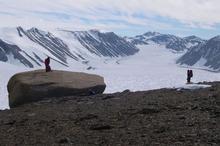Surface process dating with cosmogenic nuclides
Tiny amounts of noble gases are produced in rocks at the immediate surface of the Earth when fast elementary particles from the cosmic radiation penetrate a rock and hit a target atom, for example silicon. The concentrations of these "cosmogenic" noble gases are thus a measure of how long a rock has been at the surface of the Earth. We study these "exposure ages" of boulders on glacial moraines to date advances and retreats of glaciers in the past several ten thousand to several million years (for example in Antarctica). We also use cosmogenic nuclides to measure how fast landscapes erode in wet and dry climate zones, respectively (for example in the Atacama desert). Some samples in arid regions as Antarctica have been in place for many million years, because erosion rates are very low.
Contact
- Location location_onNW C 84
- Phone phone+41 44 633 82 28
- Fax print+41 44 632 11 79
- web_asset Detail page
Inst. für Geochemie und Petrologie
Clausiusstrasse 25
8092
Zürich
Switzerland

